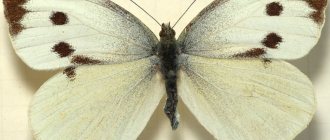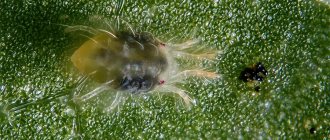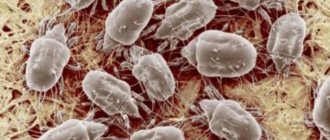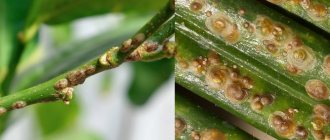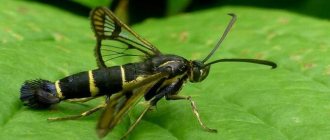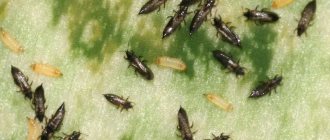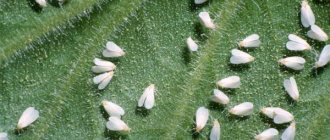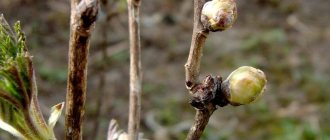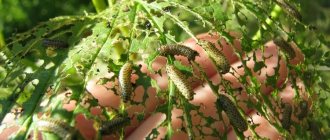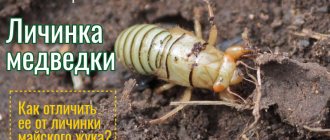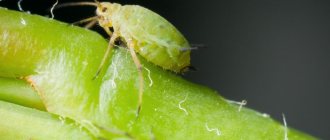Description, photo of the parasite and the affected plant
The pest feeds on plant sap. The scale insect is covered with a kind of shield, so it cannot be destroyed simply with a chemical. In the photo you can see what scale insects look like on orchids.
The scale insect sticks to the orchid leaf and drinks juice from it.
Females and males are covered with a shield that protects them from harmful influences. At the same time, males are quite mobile, and females are attached to one place and give birth to children. At one time, a female can produce 3 thousand larvae , which remain mobile for a short period of time.
Signs of appearance. How dangerous is the pest?
Scale insects and false scale insects have a rounded body. All pests of this species have one characteristic feature, by the presence of which they can be identified. This is a fairly dense shell in the form of a shield, the color of which can vary from light brown to black.
On orchids, these pests look like small growths or tubercles. They can settle on the stems of a plant, or on the underside of a leaf, choosing places near the veins. But over time, a colony of scale insects can infect other parts of the flower.
What is the danger of an orchid being affected by scale insects?:
- Parasites suck out the juices of the plant, weakening it.
- Fungal infections spread in the sticky coating secreted by scale insects.
- False scale insects are capable of injecting saliva containing a poisonous secretion. This can be noticed by small brown sores on the stems, leaves or inflorescences of the orchid.
- Colonies of scale insects slow down the photosynthesis processes of the plant.
- Leaves heavily infested with scale insects dry out and die.
Types of scale insects
differs from the false scale insect :
- Scale insects have a convex shell;
- False scale insects have a flat shell.
There are different types of scale insects that are found on orchids:
- Californian;
- Brown;
- Oleander;
- Palm;
- Cactus.
You can add scale insects to your home collection by purchasing a new plant that is already infected and has larvae on it.
IMPORTANT! Any new plant must be quarantined, where it will stand separately from other plants for 2 weeks. This time is necessary to ensure the health of the plant.
Preventative treatment
In order to protect your home plants from scale insects, you will need to take a number of preventive measures:
- You need to regularly check the quality of the substrate in the container with the plant. Pay attention to how clean and high quality it is.
- Trim weakened and dead stems in a timely manner, and the cut areas should be disinfected.
- Be sure to regularly ventilate the room in the last winter and first spring weeks. Make sure the humidity level is appropriate for the plants. If necessary, systematically moisten them with a sprayer, especially the underside of the foliage.
- Any new bush must be quarantined for 4 weeks. It is also needed by those crops that were outside in the summer. They are placed separately from other house plants and observed for some time. You can also treat plants to prevent pests and diseases.
How to identify an infection?
Scale insects prefer the hard leaves of orchids, on which they are located on both sides. They do it like this:
- They stick to one place;
- Pierce the leaf;
- And they suck the juice.
Later, a small hole with a yellow border remains . And there are a lot of such bites. All this causes great harm to the orchid. Since the number of holes grows rapidly and soon the sheet:
- Turns yellow;
- Dries out;
- And it disappears.
If treatment is not started in time, the orchid's leaf may dry out.
In this case, the waste product of the scale insect is a sticky substance located on the leaf plate. It attracts sooty fungus, which further accelerates the death of the plant.
Signs that the plant is affected by scale insects:
- Small parasites attach to all parts of the plant and this is noticeable by the light brown growths;
- When pressed, they are easily removed;
- The leaves have a transparent sticky coating;
- Leaf plates become deformed, fade and turn yellow, starting from the edge of the leaf.
If a scale insect is detected, it is worth starting treatment as quickly as possible so that it does not affect the entire orchid bush.
Scale of danger
Different types of parasites can enter a flower in several ways. This is the purchase of an already infected plant in a store, unsuitable soil (taken from a yard flower garden), an abundance of other flowers in the room. You can notice the first signs of infection by changing the appearance of the orchid. General evidence that pests have appeared on the plant:
- change in leaf shape and color;
- stem deformation;
- the green parts lose their elasticity;
- falling of flowers.
The danger of infection lies in the fact that all parasites feed on plant sap. Parts of the plant do not receive nutrients and become deformed. The flower loses its immunity, at this time it is practically defenseless. If parasites are detected late, all parts of the orchid die and the plant dies.
Attention! The appearance of mites, mealybugs, and scale insects on an orchid is dangerous because it creates a favorable environment for the appearance of fungi or rot.
Control measures
How to get rid of a pest? The first immediate step when a scale insect is detected is to separate the infected specimen into a quarantine zone.
This is necessary so that the males do not run over to neighboring flowers. Especially if the flowers are very dense.
During the entire treatment, the flower is in the quarantine zone and even 2 weeks later remains in it. This is necessary in order to be completely sure that the pest is no longer on the flower.
Way to get rid of scale insects:
- It is necessary to mechanically remove all visible shields, since the chemical will not get under them during processing;
- Wash all leaves and flower stalks with soapy water, getting rid of sticky residue;
- Only after this do they begin to process the plant.
If the infestation is small, then you can try to get rid of the insect using traditional methods , but with a large infestation they do not produce results.
Folk remedies
How to fight scale insects with folk remedies? Since this is not a new pest and people have been fighting it for a long time, there are certain folk remedies to get rid of it.
Garlic juice
To do this, cut off the tip of a clove of garlic and, using the protruding juice, treat the places on the leaf blades where the pest was noticed.
A folk remedy for fighting scale insects is rubbing the orchid leaves with garlic juice.
But if the damage occupies a large area, then the garlic is grated on a fine grater or crushed using another method, the main thing is that it releases juice and turns into pulp. After which this paste is spread on the affected leaf.
Olive oil
To do this, make a composition by mixing 2 tbsp. spoons of oil with a liter of water. The orchid is treated with this infusion with an interval of 7 days.
Soap and alcohol
To do this you need to mix :
- Liter of water;
- And 10 ml. alcohol;
- Adding 15 grams there. liquid soap or dishwashing detergent.
Mix everything thoroughly and wash the plant where the scale insect was noticed.
Biological agents
Fitoverm - fights scale insects quite well. It is used in cases where, for various reasons, it is impossible to carry out chemical treatment, and traditional methods do not help to completely get rid of it. This drug is of biological origin and is not dangerous for humans and their animals.
To make a solution of the drug, 2 ml. diluted in 200 gr. water and spray the affected plant . This drug can be used to treat other plants in the house to prevent the disease. You also need to wipe the place where the affected flower stood.
To completely remove scale insects, treatment is carried out three times after 7 days.
Fitoverm.
Promanal is considered non-toxic and is used at home not only against various types of scale insects, but also helps get rid of ticks and scale insects. It affects egg laying and the larvae die without hatching. When treating an orchid, it must be thoroughly sprayed so that the solution drips from the leaves. In this case, the substrate must also be treated, since it may contain eggs and larvae.
Promanal is a remedy that helps plants fight pests.
Avertin is a broad-spectrum drug designed to remove pests. It affects the nervous system of the pest, causing its paralysis. Processing is carried out according to the instructions indicated on the packaging.
Nemabakt - the weapon of this biological product is a nematode, which penetrates the scale insect larva and eats it. The drug is absolutely harmless to beneficial insects, people and pets. The nematode continues to fight the pest for quite a long time, and the latter has no chance of surviving against it.
Biological drug Nemabact.
Insecticides
If the orchid is completely affected by this harmful insect, then it is worth using chemicals that can save the plant. When working with such drugs, you must be careful and if they come into contact with the mucous membrane or skin of a person, you must rinse everything well under running water.
Permethrin
The drug is quite effective and one treatment is enough to remove the parasite.
Permethrin helps the orchid fight pests well.
Penetrates the scale insect through the skin.
Aktellik and Aktara
These drugs are treated three times with an interval of 5-6 days. It is very toxic and must be processed outside . Penetrates insects through the oral cavity.
Phosfamide and Methylmercaptophos
The drugs enter the insects through the sap of the plant, which becomes poisonous .
Whatever drug is chosen, it is diluted and used according to the instructions given on the package. Experienced flower growers believe that sometimes chemical treatment cannot be avoided when a large area in the greenhouse is infected or the flower itself is severely damaged by pests.
IMPORTANT! There is no need to increase the dosage or frequency of treatments - this can lead to the death of the plant.
Spider mites on an orchid
The body of a spider mite is oval in shape, its color depends on what it feeds on. It can be whitish, reddish-brown, or dirty yellow. If you look carefully at the photo of mites on orchids, you can see that an adult has 4 pairs of legs with five segments on each. The mite weaves a very thin web, which envelops the leaves, stems and flowers of plants, including orchids. Parasites multiply rapidly underneath it. Only 10-20 days pass from the moment of laying to puberty. The process depends on the environmental conditions in which spider mites live. The emerging larvae have only 3 pairs of legs; after several lines, the fourth appears. Life expectancy is only 5 days.
Spider mites on an orchid
Damage caused to orchids by spider mites
Parasites feed on plant sap. By piercing leaves or stems, they introduce a special substance into the plant that destroys cell membranes. Cobwebs appear on the leaves, they turn yellow and fall off. When there are a large number of spider mites, cobwebs appear on orchid buds. In this case, the leaves turn yellow faster, fall off and the plant dies.
It is difficult to see spider mites with naked gas, but you can see the web. If you press down lightly, the eggs will be crushed and a reddish liquid will appear. It is necessary to take measures to combat spider mites on the orchid.
How to get rid of parasites
Spider mites on an orchid can be destroyed in different ways. First, wipe the affected plant well. The more carefully this is done, the more eggs and adults can be removed. It is necessary to treat the orchid using liquid or laundry soap. Add 1 tbsp to 1 liter of water. spoon of ingredient. Using a sponge soaked in the solution, treat the surface of the stem and each leaf.
After this, you need to pour a soapy solution over the substrate, cover the flower with a plastic bag and leave for 3-4 days. As a result of increased humidity, spider mites will die.
Chemicals
The following products have proven their effectiveness:
- Actellik. The drug is sold in a 2 ml package, the price is 27 rubles. Flowers are sprayed with a solution prepared according to the instructions.
- Neoron. The cost of one ampoule (12.5 ml) is from 70 to 120 rubles. It has an immediate effect. It must be used immediately after preparing the solution.
- Fitoverm. The drug, created on the basis of aversectin, has an effective effect in the fight against spider mites on indoor plants. Penetrating into the body through the contact-intestinal route, it has a negative effect on the nervous system of parasites. It goes on sale in bottles and ampoules (2 ml, costing about 15 rubles). To prepare the solution, dissolve the contents of the ampoule in 1 liter of water. The resulting mixture is sprayed onto the plant.
- Karbofos. The active ingredient is malathion. It has a quick effect on ticks. A package containing 30 g of product costs about 30-32 rubles. The solution is prepared according to the instructions.
Anti-spider mite remedies
Traditional medicines
You can get rid of mites on an orchid using simple and affordable means.
Infusions and decoctions made from herbal ingredients help well.
- Chop 2 heads of garlic, add one liter of water and leave in a dark place for 5 days. After this, you should filter the resulting mixture, add the same amount of water and spray the orchid with the resulting solution.
- Dilute 60 g of dry mustard in a liter of water and leave for 3 days. Plants are treated with the prepared composition.
- 100 g of onion peels are poured with 5 liters of water and left for 5 days. The affected areas of the orchid are treated with the strained solution.
- Pour dandelion roots and leaves with a liter of hot water and leave for 3 hours. Use the strained infusion to treat affected areas.
Root mites are found on orchids. It is often called allium or bulbous (Rhizoglyphus echinopus). The body has the shape of an ellipse, the color is white, light yellow, the legs are strong brown. It is almost impossible to detect it, since it lives at the base of the roots.
Application of growth stimulants and nitrogen fertilizers
When getting rid of pests, you should not use :
- Various fertilizers;
- Growth stimulants.
At the time of illness, the orchid will not grow new leaves and it will not accept the stimulant. Therefore, an excess of nitrogen fertilizing will lead to softness of the leaf plates and the possibility of their rotting. All the flower needs is a poison that will rid it of the pest.
Mealybugs
You can find out about the presence of mealybugs on an orchid by plaque on the substrate, roots or inner walls of the pot. This cotton-like substance forms around female scale insects, which are always motionless. If you lift such a “yarn,” you can see both the insects themselves and their eggs. Most pests accumulate on flowers and peduncles, as well as on the inside of leaves.
Reason for appearance
The main reason for the appearance of mealybugs on an orchid is considered to be a violation of the conditions of detention. Weakened plants or specimens overfed with nitrogen fertilizers are much more susceptible to pest damage than healthy orchids.
How to get rid of mealybugs
Every day, morning and evening, you need to remove scale insects from the orchid using a toothpick or a soft thin stick. After this, the places where the insects were located must be treated with a cotton swab moistened with water or liquid soap.
Along with this, the substrate and the lower part of the orchid must be sprayed with Fitoverm (2 times at intervals of a week).
Treatment can be considered successful if not a single new insect is found on the orchid within a month.
Mealybug on an orchid flower
Folk remedies
An oily spray can help control mealybugs. It consists of 2 tbsp. olive oil and 1 liter of water. This emulsion should be sprayed onto the orchid using a sprayer.
Flower growers also speak well of an alcoholic solution with soap. It is made up of 15 g of liquid soap, 10 ml of denatured alcohol and 1 liter of water. Keep in mind that the product is not suitable for orchids with thin leaves.
When buying a new orchid, you need to carefully check it for pests, since there is always a risk of purchasing a plant that is already infested with mealybugs. The second important measure is periodic inspection of all specimens of the home flower garden. After all, once mealybugs settle on one plant, it will be extremely difficult to get rid of them. Don’t forget about proper care, the main components of which are good lighting and high air humidity.
